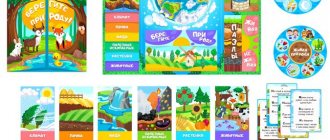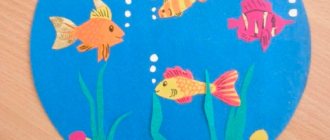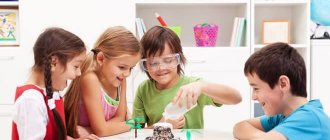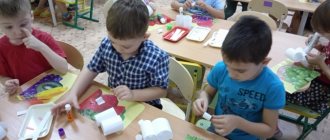All that is needed
For the experiment you will need some household chemicals and decorative elements to create an island. The volcano island can be made from natural materials or use dinosaur sensory box sets.
A model of a volcano is made from plasticine. Creating a fabulous volcanic island for the experience is the main component of it and serves to develop the child's imagination and creativity. Such activities will help instill a love for chemistry and geography. The child will develop fine motor skills of the fingers while making plasticine terrain and its inhabitants.
To make an island you need:
- cardboard;
- stapler or narrow tape;
- box with colored plasticine;
- small animal toys;
- colorful pebbles;
- a large plastic box or bowl in which the island will stand;
- glass or plastic container with a volume of 200 ml for the volcano crater.
To conduct the experiment you will need:
- soda 20 g;
- food coloring:
- vinegar 9%;
- dish detergent 25 ml;
- water 100 ml.
Usually the experiment continues until mom runs out of all the baking soda and vinegar, so be patient.
Children cannot carry out the experiment on their own without adults. If vinegar gets into a child's eyes or mouth, it can cause a burn to the mucous membranes, and if swallowed, it can cause a burn to the esophagus.
rushing river
To create a river that will boil you will need:
Read also: How to make a machine with your own hands
- Plastic pipe.
- Sodium bicarbonate.
- Vinegar.
- Water.
- Food coloring
Do the following:
- Take a plastic pipe and cut it lengthwise.
- Place a makeshift river bed in the bathtub.
- Mix soda and citric acid in a 2:1 ratio.
- Prepare a vessel with water.
- For added color, you can add food coloring to the water or soda mixture.
- Pour baking soda and vinegar into the channel.
- Gradually add water.
From the actions taken, the water will run and foam. If you close the drain, the bath will be a kind of colored lake.
Making a fairytale island
You can build an island in a large plastic container. Pour real water and line the bottom with round pebbles. Make a container for the volcano from a baby food jar or an old glass. For the mountain inside which the container will stand, you need to make a cardboard model; your child will be happy to cover it with plasticine.
The sequence of making a volcanic mountain:
- cut out a circle of the required diameter from thick cardboard;
- make a cut from the edge to the center of the circle;
- roll up a cone;
- the edges of the cone are fastened with a stapler or tape;
- cut off the upper part of the cone at a height equal to the container chosen for the volcano;
- place the container inside the cone.
I coat the top of the mountain with plasticine. To do this, roll out small brown plasticine cakes and stick them to a paper cone, completely covering the cardboard. The top of the volcano can be made of red plasticine, which will imitate hot lava.
They place a volcanic mountain on a dry island of pebbles. They are seated around small rubber animals that are among children's toys. Multi-colored amazing dinosaurs or wolves, foxes, bunnies, bears and other inhabitants of the forest and jungle. Depending on what animals were planted, vegetation for the island is selected. Large tree ferns and horsetails for dinosaurs, and ordinary fir trees and birches for bunnies and foxes.
Plastic plants are also often sold in sets for children's games. You can use a leaf of a living fern and twigs of plants if it is summer outside.
Plants can also be molded from plasticine, made from threads and beads or ordinary cardboard.
You can make small houses out of cardboard for plastic Indians and soldiers. It is better to use cardboard to make plants and houses when the island is in a container with blue-dyed sand instead of water or on a blue plasticine sea.
Boiling water in a glass
When you don’t have plasticine or a bottle at hand, you can use an ordinary glass to set up the experiment. The child can be told that the water will now boil without exposure to heat.
Recommended for you: How to soften water with baking soda at home
To do this you need:
- Cup.
- Lemon acid.
- Sodium bicarbonate.
- Water.
Follow these steps:
- Place the vessel on the tray;
- Add 2 tsp to a glass of water. NAHCO3;
- Add a teaspoon of lemon acid.
Instead of soda, you can add vinegar or citric acid (2.5 tsp of vinegar or citric acid per 500 ml of water).
Then boiling water is obtained. When sodium bicarbonate and citric acid or vinegar come into contact with water, they interact, causing the water to boil.
Conducting an experiment
Finally the island is ready. All the toy animals and people froze in anticipation of an interesting event - a volcanic eruption. They know that the volcano is not real and therefore are not afraid of it.
To conduct the experiment, pour a tablespoon of soda into the volcano jar. Add a tablespoon of dishwashing detergent. Red or orange food coloring is dissolved in 100 milligrams of water and added to the baking soda and detergent. The base for the experiment is ready, all that remains is to add vinegar. For mom, you can let your child pour vinegar into the volcano on his own, under her supervision, so that he doesn’t do it in her absence. It is better to repeat the experiment for an encore, pouring vinegar into the “mouth” of the volcano and pouring soda into it until the child is interested in it and asks to repeat the experiment.
When vinegar is added, the baking soda will begin to foam, erupting from the “volcano mouth” like red or orange lava. The detergent will allow the “lava” to foam longer and more abundantly, overflowing from the vent and flooding the surrounding area along with plants and animals that were carelessly located too close.
Progress of the game
Znayka comes to visit the children. He talks with the guys about the content of the fairy tale “The Three Little Pigs”
;
finds out what materials people use to build houses: “What is good about a wooden house? (It is beautiful, warm, bright, cozy, easy to breathe in.)
What could harm this house?
(Fire, dampness)
What can you say about a brick house?
(Brick is durable, strong; building material can be white or red) What other material can you build a house from? (Made of concrete)
."
The teacher suggests approaching the concrete wall of the kindergarten and determining what it is like. The children find out that the wall is smooth, solid, and durable. The teacher suggests: “Now you and I will try to make concrete ourselves. For this we have sand, water, crushed stone, cement.”
The teacher and children mix all the ingredients and pour them into different molds; the teacher explains that these molds are called formwork: “In order for the concrete to become strong, it is poured into the formwork and left to harden. From time to time the surface is moistened with water. A small amount of concrete can be made by one person. If a lot of concrete is required, it is made at a concrete plant.” Children look at photographs showing a concrete plant, its workshops, concrete mixers that mix the necessary components of a container for pouring concrete, and cranes that lift finished slabs.
Experiment “How to inflate a balloon?”
Materials:
1) soda
2) vinegar
3) plastic bottle
4) balloon
Experience . "Real" volcano
The children's delight will know no bounds if they jointly build a model of the volcano and try to give it the appearance of the original. In this matter, the experience and enterprise of parents will come in handy. What to do:
- Cover the container with plasticine, making it look like the neck of a volcano.
- Place the dishes on a tray and fill them almost halfway with baking soda.
- Pour in a few tablespoons of vinegar.
- Lastly, pour sequins or sparkles into the mouth. If they end up at the very bottom, stir them with a wooden stick. The flowing foam will entail sequins, simulating a real eruption, which in natural conditions occurs with the extraction of fragments of stones and magma from the depths of the earth.
The base of the “volcano” can be molded yourself from new or used plasticine, or from salt dough.
Model made of paper and plasticine
A volcano can be created from paper and plasticine. To make it, you will need a thick sheet (from 220 g/sq. m) and plasticine of different colors: brown, green, red, yellow.
To begin with, make a paper base. A large circle is drawn on the sheet, and inside it is another one of small diameter. These circles are cut along the contour, cut from the edge to the central hole and glued together in the shape of a truncated cone. This cone will imitate the body of a volcano, and the hole on top will be its mouth.
Next, plasticine of different colors is molded onto the base of the volcano. Brown and green colors are used below - they depict earth and grass. For the base of the mountain they take brown and yellow plasticine, for the vent - red, orange, black. From plasticine you can make lava flowing down a slope, fire splashing out of a crater, and stones flying down. Such a volcano can be placed on a wooden, plastic, or cardboard stand.
Experience . Boiling Lake
You need to use your imagination, imagining that a bowl of water is a huge body of water and tell your child about it. Children are dreamers and can easily be drawn into play. For the experiment you will need:
- Dishes.
- Soda.
- Vinegar or citric acid.
How to make a “boiling” lake:
- Add a little soda and citric acid to the water and the pond will begin to bubble.
- Give your child the opportunity to do it himself - he will like it.
- Throw in the components one at a time, changing their sequence to cause further “boiling” of the liquid.
The boiling lake actually exists. It is located on the territory of Kunashir (Kuril Islands) and is heated by volcanic gases, hence the name of the reservoir. The most interesting thing is that it is connected by an artificial canal to a lake called Goryacheye.
colored lava
You can also make many volcanoes with different colored dyes.
To organize the experience you will need:
- Small cups or baby food jars in the amount of 6 pcs.
- Gouache of different colors.
- Sodium bicarbonate.
- Water.
- Vinegar.
- Tray.
The following actions are performed:
- Balls of 6 different colors are rolled out of soda and gouache.
- Place the vessels on a tray.
- Pour vinegar into them.
- Place prepared balls into each vessel.
Recommended for you: How to make play dough from soda: do it yourself, at home
A colorful violent reaction will occur. You can also watch how different colors are mixed on a tray.
Made from plasticine and paper
It will be even faster to model a volcano from paper and plasticine. First, let's create the shape of the product. Take a piece of cardboard, fold it to form a cone, and cut off the top of the resulting cone. A model of a volcano made at home.
Now stick plasticine on top of the resulting model, you should get a mountain. Place the layout on a tray or platter. Place the lava mixture (food coloring, paint, soda) into a jar and place the jar inside the craft. The homemade volcano is ready. You can make such a product quickly, simply and without much expense.
Salt dough volcano
For the experiment you need a minimum of materials and a little patience. To make a volcano model with your own hands, you will need:
- Tray;
- Plastic bottle;
- Food paint;
- Foil;
- Dishwashing liquid;
- Salty dough;
- Vinegar;
- Baking soda.
After we have found everything we need, we begin modeling. Let's get started by following the instructions:
- To begin, take a plastic bottle and cut it into two equal parts. Place its upper part on a tray with its neck facing up.
- Take the foil and cut it into strips, wrap them around the bottle so that you get a mountain.
- Then make the salt dough, divide it into 3 parts and carefully place it on the foil, completely cover the foil with the dough. To make the volcano more realistic, paint its mouth with food coloring.
- Next we will do the experiment itself. To begin, take a few teaspoons of baking soda and pour the baking soda into the bottle, then add one and a half tablespoons of dishwashing liquid.
- Take a glass and pour a little vinegar into it, after tinting it with food coloring.
- Pour the resulting liquid into the volcano and colored foam should flow from the crater. The kids will definitely love the result.
Volcano made using papier-mâché technique
This technique is more difficult, but children enjoy using it. They are fascinated by the opportunity to tinker with wet paper and create crafts of any size and shape with their own hands.
Preparing materials and tools:
- plastic bottle with a volume of 0.5 l;
- cardboard or plywood for the base;
- white paper, newspapers - a lot;
- PVA glue and water, mixing container;
- scissors and the desire to create.
Let's get started - cut off the top of the bottle so that a fairly narrow neck remains. We tear newspapers into pieces in any shape, cut white paper into thin strips - about 1 cm wide.
We attach the cut bottle to the base with PVA glue and let it dry. Now it's the turn of the slopes - we make them from strips of paper.
We reinforce the vertical strips with horizontal ones. The “window” step between them cannot be more than 1.5 cm.
The main work begins using the papier-mâché technique. In a container, dilute PVA glue with water in a ratio of 1*1, place newspaper scraps into the solution. Then we take them out one at a time and place them on a piece of paper strips.
The last layer will be pieces of white paper, glued according to the same principle.
The last stage is coloring. You can start working on it only after the workpiece has completely dried. This may take up to 2 days.
You can deviate from the described technology and go a slightly different way. More details in the video tutorial:




